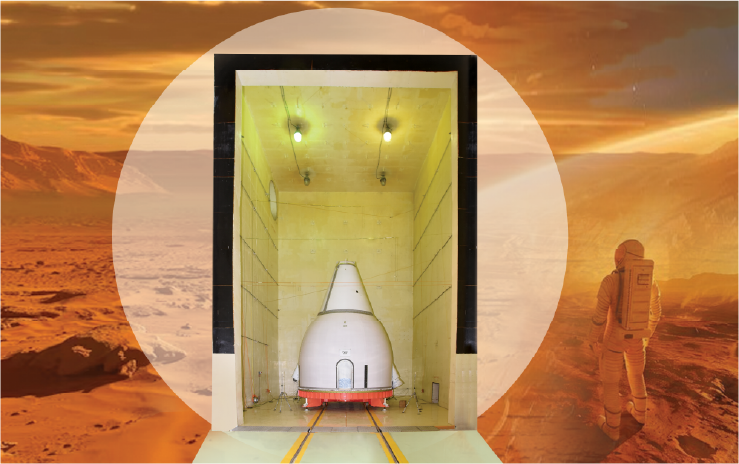
Council of Scientific and Industrial Research(CSIR)-National Aerospace Laboratories(NAL),a constituent of the Council of Scientific and Industrial Research(CSIR), India, established in the year 1959 is the only government aerospace R&D laboratory in the country's civilian sector.
CSIR-NAL is a high-technology-oriented institution focusing on advanced disciplines in aerospace. Within a decade of its establishment, NAL's 1.2-meter trisonic wind tunnel commenced operations. This facility was an engineering marvel for its time, capable of providing vital, strategic, and secure experimental aerodynamic data. Over the years, CSIR-NAL scientists have developed novel and advanced wind tunnel testing techniques, which contribute immensely to every Indian aerospace programme led by either CSIR, DRDO, HAL or ISRO. Every Indian aerospace vehicle, be it the MiG, Su-30 or Tejas aircraft, or the Gaganyaan, Chandrayaan and Mangalyaan space vehicle, has graduated out of the NAL wind tunnel.

The Indian Space Programme has been ably supported by the CSIR NAL's Acoustic Test Facility (ATF) over the last three decades. This national facility is dedicated to acoustic environment qualification testing of satellites, launch vehicle stages and their sub-systems for ISRO. Its involvement and contributions in ISRO's successful mission programs, including India's upcoming ambitious Gaganyaan have been commendable. In the next decade, NAL set up its marvellous Full-Scale Fatigue Test Facility. This facility allowed the Indian Air Force to extend the service life of its fighter aircraft without jeopardizing safety. The economic benefit of such a facility has been invaluable to the country.

CSIR-NAL developed 165 carbon composite parts for LCA Tejas using the innovative co-cured co-bonded approach. This has resulted in a weight saving of at least 20% due to improved stiffness of the composite materials and reduced number of parts. Such technological successes also lead to very valuable spin-offs. For example, this process pioneered the indigenous design and development of autoclaves, as well as the infield repair of composite structures. NAL has also mastered the design and development of radomes for both airborne and ground-based applications; the ground-based X-band weather radar for ISTRAC-ISRO is one example.

Recently certified, HANSA NG boasts an all-glass cockpit, bubble canopy, and a fuel-efficient engine, leading to excellent endurance. Hansa-NG will be an excellent aircraft for flight training by Indian Flying Clubs as well as other customer applications like bird reconnaissance at airfields, cadet training, coastal surveillance, and hobby flying. The aircraft has been certified by DGCA and Production version of HANSA-NG has started assembly in the hangar.

NAL is currently engaged in the detailed design of SARAS Mark II, India's first indigenous 19-seater commuter aircraft. SARAS Mark II is the successor to the 14-seater SARAS Mark I, which was successfully designed and first flew in 2004. The insights gained from SARAS Mark I are being utilized to enhance the aerodynamic configuration so that it meets the requirements of the Indian Air Force, which is the launch customer. SARAS-Mk II is a 19-seat light Transport Aircraft with multirole capabilities like Passenger transport connecting Tier-2 & Tier-3 cities, Troop transport, VIP transport and Casevac (Air Ambulance).

The High-Altitude Platform (HAPS) is yet another commendable cutting-edge development from CSIR-NAL. Recently, the subscale vehicle(1:3) flew for over 10 hours at an altitude of 25000 ft. using hybrid solar and battery power. The day is not far when the country will achieve 24/7 perpetual flight with a full-scale HAPS flying at 20 km altitude - a feat achieved by barely two other countries worldwide. This, aircraft will lead to a paradigm shift in the strategic and telecommunication domain of the nation.

Wankel engines of 30, 55, and 65 hp, designed, developed, and certified at CSIR-NAL, are being deployed in DRDO projects. These internal combustion engines boast a low weight compared to other engines in the same class.

In recent years, India has witnessed a revolution in the drone space with numerous startups introducing innovative concepts. CSIR-NAL has ventured into this space, delivering quadcopters and octocopters for drug delivery, pesticide spraying, hyperspectral imaging, and geo physical exploration. These have been transferred to half a dozen industry partners. The Q-plane, designed by CSIR-NAL, is capable of vertical take-off and landing, with a to-and-fro range of 20 km. The Border Security Force has taken keen interest in this product.

CSIR-NAL has been rendering yeoman service to the aeronautical community of the country using the multi-disciplinary expertise built over five decades of dedicated work, to analyze and identify causes of failures of engineering structures and of aircraft accidents/ incidents.
Through its contributions over the years, CSIR-NAL has created a niche in advanced aerospace research and technology development, providing significant value-added inputs to all Indian national aerospace programs.










